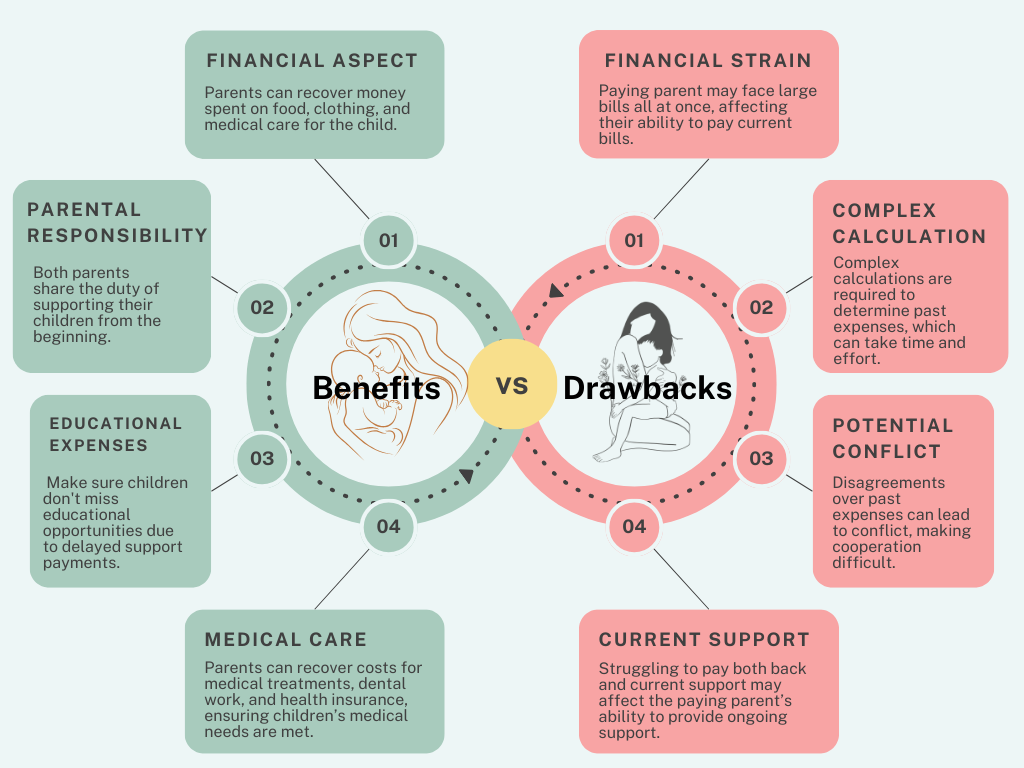Every parent is legally bound to pay for their child from the moment the child is born. But what happens when one of the parents declines to provide for the child?
Child support matters often bring up questions about past expenses and payments. If one parent was not involved in any financial responsibility of the child, retroactive child support is the solution.
However, these payments exist to help children get the care they needed in the past. Understanding how retroactive support works helps parents make better choices about their children’s financial needs.
This guide explains the key points about requesting and receiving adequate child support.
What is Retroactive Child Support
Many parents don’t know they can ask for support money before their court case starts.
This back payment, called retroactive child support, helps cover costs from when one parent wasn’t helping financially.
For example, if a mom spent two years raising a child alone before going to court, she might ask for support covering those years.
The time frame for these payments varies by state. Some places limit how far back parents can claim, while others look at the whole period since the child’s birth.
When Can Retroactive Child Support Be Claimed
Claiming retroactive child support depends on several key situations.
First, you can ask for it when you first file for child support. Many parents don’t know they can do this, but courts often allow claims from the date of separation.
You might also claim when there’s been a clear change in the other parent’s income. For instance, if you find out your ex got a big raise two years ago but didn’t tell you, you could ask for back support based on their higher income.
If you have just found your child’s other parent after years of raising your kid alone, you can request support for past expenses.
Here’s what courts typically look at:
- How long you waited to make the claim
- Why you didn’t ask for support earlier
- If the other parent knew they should pay
- Your child’s past needs and expenses
- The paying parent’s ability to pay now
Steps to Claim Retroactive Child Support

Claiming retroactive child support can be a complex process, but following the right steps makes sure that you have the best chance of receiving what you are owed. Below are some steps to follow:
Step 1: Understand Eligibility for Retroactive Child Support
- Check your state’s laws regarding retroactive child support, as rules vary.
- Determine if the other parent had a financial obligation before the formal support order.
- Identify the period for which you can claim retroactive support.
Step 2: Gather Necessary Documentation
- Collect proof of unpaid support, including past agreements or informal arrangements.
- Obtain records of expenses related to raising the child, such as medical bills and school fees.
- Keep communication records that show efforts to seek support from the other parent.
Step 3: File a Petition for Retroactive Child Support
- Visit your local family court to obtain the necessary forms.
- Complete the petition, specifying the time frame and amount sought.
- Attach supporting documents, such as financial records and proof of custody.
- File the petition with the court and pay any applicable fees.
Step 4: Serve the Other Parent with a Legal Notice
- Arrange for legal service of the petition to the other parent as required by law.
- Ensure proper documentation of service is filed with the court.
- Allow the other parent time to respond as per the legal deadline.
Step 5: Attend the Court Hearing
- Prepare to present evidence supporting your claim for retroactive support.
- Be ready to answer questions about financial needs and past child-related expenses.
- The other parent may provide counterarguments, so have responses prepared.
Step 6: Receive the Court’s Decision
- If approved, the court will issue an order specifying the amount and payment schedule.
- The other parent may be required to pay in installments or a lump sum.
- If denied, you may have options for appeal depending on state laws.
Step 7: Enforce the Retroactive Support Order
- If the other parent fails to pay, seek enforcement through wage garnishment or tax refund interception.
- Work with child support agencies or legal professionals to ensure compliance.
- Keep track of all payments received and report any non-compliance to the court.
List of Evidence to Claim Retroactive Child Support
Getting retroactive child support means showing proof of past expenses and situations. Courts need solid evidence to make fair decisions about back payments.
Here’s what parents should gather to support their claims:
| Type of Evidence | Examples | Why It Matters |
|---|---|---|
| Financial Records | Receipts, bank statements, credit card bills | Shows actual expenses paid for childcare |
| Living Arrangements | Lease agreements, utility bills, school records | Proves primary caregiver status |
| Communication History | Texts, emails, and letters about child expenses | Documents attempt to get support |
| Medical History | Doctor visits, prescriptions, insurance payments | Shows healthcare responsibility |
| School Documents | Tuition bills, supply receipts, activity fees | Demonstrates educational expenses |
| Work History | Pay stubs, tax returns, employment records | Establishes income levels |
| Witness Statements | Teachers, family members, childcare providers | Confirms care arrangements |
| Attempt to Contact | Phone records, letters, legal notices | Shows effort to seek support |
| Government Assistance | Food stamps, medical assistance records | Indicates financial need |
| Shared Expenses Agreement | Written plans, informal agreements | Shows intended arrangements |
These pieces of evidence help build a strong case for back support. Remember to organize everything by date and keep copies of all documents.
Courts appreciate well-prepared claims that clearly show why retroactive support makes sense.
Benefits and Drawbacks of Retroactive Child Support

Conclusion
Looking back at what we’ve learned about retroactive child support, it’s clear that this system helps fill gaps in a child’s care.
The process might initially seem complex, but it is important in family law.
Taking that first step to claim or respond to retroactive support might feel hard, but it’s worth it for your child’s well-being.
Need help with your situation? The first step is talking to a family law professional in your area. They can guide you through the process and protect your rights as a parent.
Frequently Asked Questions
How is Retroactive Child Support Paid?
Retroactive child support is paid through a lump sum or installment plan, depending on the court’s decision.
What is Retroactive Child Support in Texas?
In Texas, retroactive child support is the amount owed for the period before a formal child support order was in place.
How Does Back Child Support Get Paid?
Back child support is typically paid through wage garnishment, tax refunds, or direct payments to the custodial parent.
How Far Back Can Child Support Be Claimed in Texas?
In Texas, retroactive child support can typically be claimed for up to four years unless the court finds evidence of intentional avoidance of support obligations.








